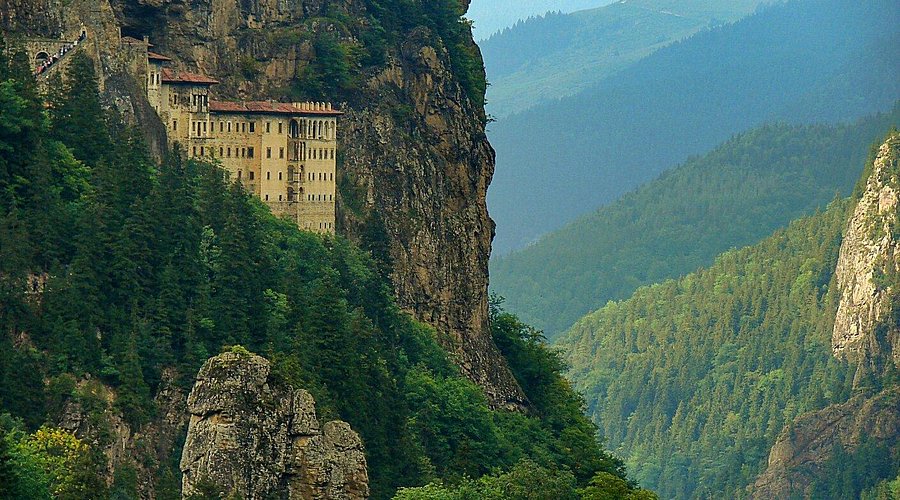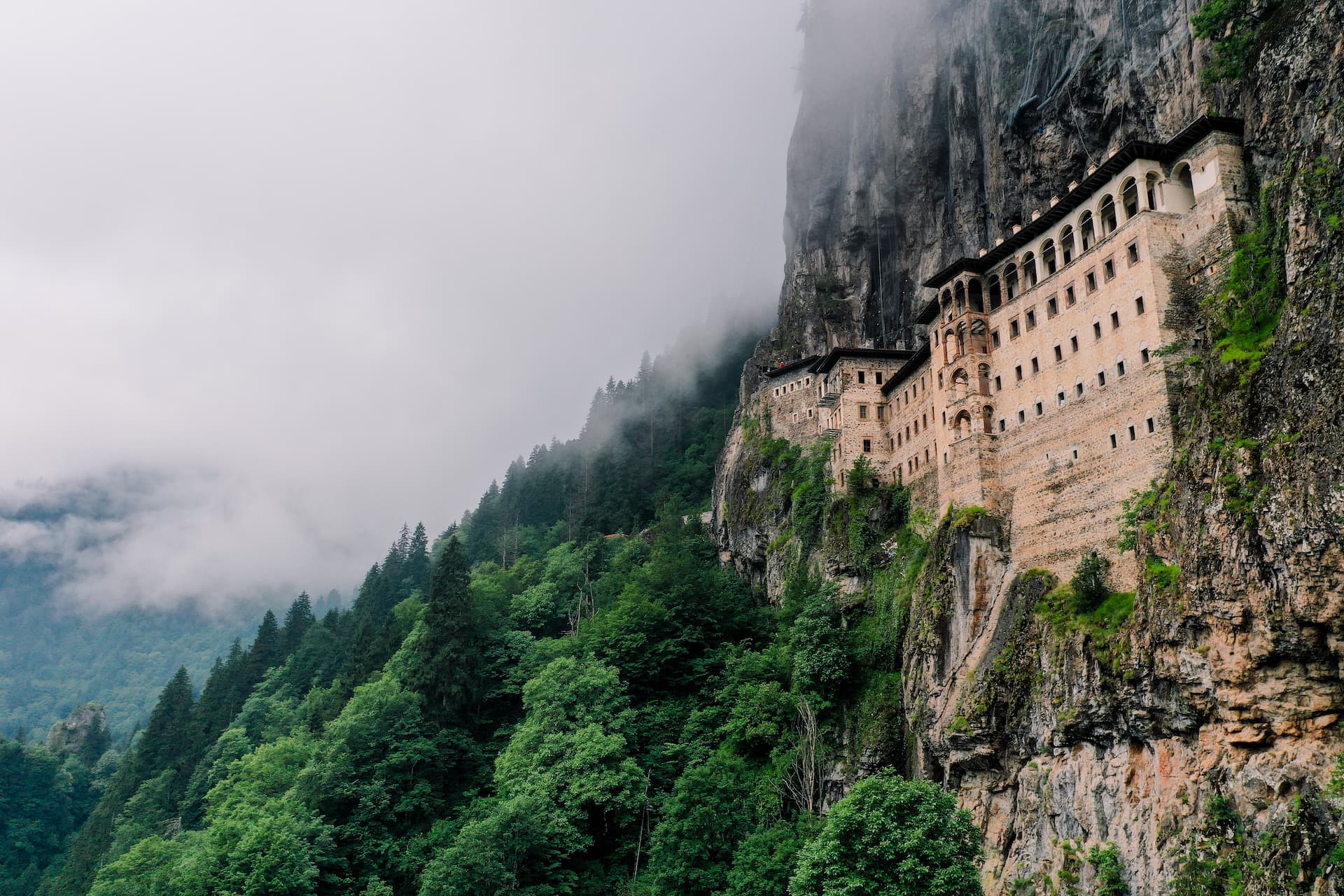Sumela Monastery: A Complete Travel Guide to Turkey’s Cliffside Wonder
Perched dramatically on the steep cliffs of the Altindere Valley in northeastern Turkey, Sumela Monastery stands as one of the most breathtaking historical and spiritual sites you’ll ever encounter. This ancient Greek Orthodox monastery, dedicated to the Virgin Mary, dates back to the 4th century and represents an incredible feat of architectural determination and religious devotion. The monastery’s name derives from “Melas,” meaning “black” in Greek, referring to both the dark-colored mountains and the Black Madonna icon around which the complex was built. Visiting Sumela Monastery offers you not just a glimpse into Byzantine history but an unforgettable adventure combining natural beauty, cultural heritage, and spiritual significance. The recent extensive restoration following years of closure makes now the perfect time to experience this UNESCO World Heritage tentative site in all its glory.
Sumela Monastery Essential Information – What Every Traveler Should Know
Before embarking on your journey to Sumela Monastery, understanding its historical context and practical realities will significantly enhance your experience. The monastery complex spans multiple levels carved directly into the rock face at an altitude of approximately 1,200 meters (3,900 feet), requiring a moderate hike to access. The main church features stunning frescoes depicting biblical scenes that have survived centuries of weathering and human intervention. Recent restoration work has carefully preserved these artworks while ensuring structural safety. The Turkish government has implemented visitor management systems to protect the site, including timed entry during peak seasons. You’ll want to allocate at least 2-3 hours to fully appreciate the monastery, surrounding trails, and panoramic viewpoints.
Historical Significance – Understanding the Timeline
- Founded in 386 AD during the reign of Emperor Theodosius I, making it nearly 1,700 years old
- Flourished during the Komnenian dynasty in the 13th century when it gained imperial protection
- Abandoned in 1923 following the population exchange between Greece and Turkey
- Underwent major restoration from 2015-2020 before reopening to visitors
- Budget traveler: $25-40 per day including shared transportation, park entrance, and self-guided visit
- Mid-range experience: $60-90 per day with private transport, guided tour, and meals
- Luxury option: $120-200+ per day including premium guided tours, specialized photography permits, and luxury accommodations
- Turkish Ministry of Culture and Tourism Official Site
- UNESCO World Heritage Tentative List Information
Architectural Marvel – How It Was Built
The construction of Sumela Monastery represents an extraordinary achievement in pre-modern engineering. Builders carved rooms, chapels, and storage areas directly into the cliff face while constructing wooden balconies and staircases that seem to defy gravity. The complex includes a rock church, several chapels, kitchens, student rooms, a guesthouse, library, and sacred spring believed to have healing properties. The main church’s interior and exterior walls are covered with frescoes dating from various periods, with the earliest from the 9th century and the most extensive from the 19th century. The combination of natural cave formations and human craftsmanship creates a unique architectural dialogue between nature and devotion.

Sumela Monastery Planning Your Trip – Seasons, Budget, and Preparation
Planning your visit to Sumela Monastery requires careful consideration of seasons, transportation options, and physical preparedness. The monastery is located within Altindere National Park near Trabzon, a region known for its lush greenery and frequent rainfall. The best months to visit are between May and September when weather conditions are most favorable, though even summer months can see sudden weather changes. You’ll need to account for transportation from Trabzon, entrance fees, and potentially guided tour costs. Physical preparation is important as the access trail involves a steady incline and numerous steps. The journey is manageable for most fitness levels but challenging for those with mobility issues. Proper footwear, water, and weather-appropriate clothing are essential regardless of when you visit.
Best Time to Visit Sumela Monastery
The ideal time to experience Sumela Monastery is between late May and early October when the weather is most predictable and the hiking trails are driest. July and August offer the warmest temperatures (averaging 20-25°C/68-77°F) but also attract the largest crowds. Shoulder seasons (May-June and September-October) provide milder conditions with fewer visitors. Winter visits (November-March) are possible but challenging due to potential road closures, snow-covered paths, and limited opening hours. The monastery occasionally closes during heavy snowfall. Spring brings spectacular blooming rhododendrons and waterfalls throughout the valley, while autumn offers stunning foliage colors. Check the official website for current opening times as they vary seasonally.
Budget Planning and Costs
Essential Preparation Checklist
Proper preparation ensures your Sumela Monastery visit is safe and enjoyable. Start by checking the official website for any closure notices or special requirements. Wear sturdy hiking shoes with good grip as the path can be slippery, especially after rain. Bring layers as temperatures can change rapidly at altitude. Pack water and snacks as facilities are limited at the site. Consider hiring a guide for deeper historical context – available at the entrance in multiple languages. If photographing the frescoes, check current rules about flash photography. Carry cash for entrance fees and potential additional costs. Those with mobility concerns should inquire about accessibility options, though the steep terrain presents significant challenges for wheelchair access.
Sumela Monastery Top Attractions and Activities – Beyond the Main Complex
While the monastery itself is the primary attraction, the surrounding Altindere National Park offers additional experiences that complement your visit. The hiking trail to the monastery winds through beautiful forest with several viewpoints overlooking the valley below. Within the complex, don’t miss the Rock Church with its breathtaking frescoes, the library section, the monks’ quarters, and the sacred spring. The viewing platforms provide spectacular photo opportunities of the monastery seemingly glued to the cliff face. During your descent, consider exploring the smaller caves and religious sites scattered throughout the valley. The entire area holds spiritual significance for both Christian and Muslim visitors, creating a unique atmosphere of interfaith respect and historical continuity.
Must-See Highlights Within the Monastery
The main church (Katholikon) represents the artistic and spiritual heart of Sumela Monastery, featuring frescoes that depict scenes from the Bible and the life of Christ. The artwork on the northern wall shows the creation of Adam and Eve, while the southern wall illustrates miracles of Jesus. The apse contains a magnificent depiction of the Virgin Mary with child, the central icon around which the monastery was built. The kitchen area with its blackened walls from centuries of cooking fires offers a glimpse into daily monastic life. The aqueduct system that brought water to the complex demonstrates impressive ancient engineering. Don’t miss the guest rooms where pilgrims stayed and the library that once housed valuable manuscripts, many of which were moved to Ankara’s Museum of Ethnography for preservation.
Hidden Gems and Local Favorites
Beyond the main tourist path, several lesser-known features reward curious explorers. The pathway behind the monastery leads to smaller caves and chapels that many visitors miss. The Valley of the Virgin Mary (Meryemana Vadisi) below the monastery features beautiful walking trails alongside rushing streams and waterfalls. Local guides can point out specific frescoes that tell unique stories, such as those depicting the monastery’s founding legend. The nearby town of Maçka offers authentic Black Sea cuisine in family-run restaurants. For a truly local experience, visit during the August 15th celebration of the Virgin Mary’s Dormition, when special ceremonies attract pilgrims despite the site’s museum status. The viewpoint from across the valley provides the classic photograph perspective that appears in many travel publications.
Sumela Monastery Practical Travel Information – Transportation and Accommodation
Reaching Sumela Monastery requires planning as it’s located 46 kilometers (29 miles) south of Trabzon, the nearest major city. Most international visitors fly into Trabzon Airport (TZX), which receives flights from Istanbul and other Turkish cities. From Trabzon, you can take a bus, hire a taxi, or join a guided tour to the monastery. The final approach involves a well-maintained but steep hiking trail of approximately 1.5 kilometers (0.9 miles) from the parking area. Accommodation options range from hotels in Trabzon to guesthouses in Maçka, the nearest town. The region offers various dining options featuring Black Sea cuisine, known for its fish dishes, cornbread, and unique dairy products. Cellular service is available but can be spotty in the valley.
| Category | Options/Features | Price Range (USD) |
|---|---|---|
| Transport from Trabzon | Bus, taxi, or rental car | $15-50 round trip |
| Entrance Fee | National park and monastery access | $5-10 per person |
| Guided Tours | 2-4 hour tours available at entrance | $20-40 per group |
| Accommodation | Hotels in Trabzon or guesthouses in Maçka | $30-150 per night |


